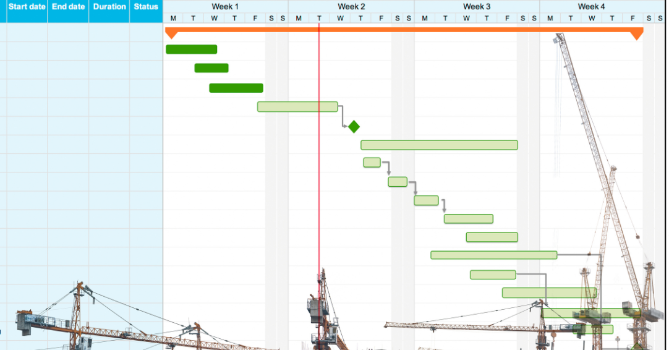.png)
4D BIM Sequencing and Simulation: The Key to Cost-Effective Project Management
Introduction
4D Building Information Modeling (BIM) is changing the way construction projects are managed. Unlike traditional 3D BIM, which focuses on the design and structure of a building, 4D BIM adds time and scheduling to the model. This means project teams can plan out each phase of construction and visualize how the project will unfold over time.
By using 4D BIM sequencing and simulation, construction professionals can optimize processes, reduce delays, and improve overall project efficiency. It helps teams identify potential problems before they happen, making adjustments early to save time and money.
This blog will explore how 4D BIM is becoming a key tool in cost-effective project management. We’ll look at its benefits, how it works, and why more construction companies are adopting it to streamline their projects and achieve better results.
What is 4D BIM?
4D BIM adds a crucial element to traditional 3D models: time. While 3D BIM focuses on the physical design of a building, 4D BIM incorporates the project timeline, allowing teams to link scheduling with the construction process. This gives project managers the ability to plan, schedule, and track every phase of a construction project from start to finish.

With 4D BIM, teams can create detailed construction schedules that show how different phases will unfold over time. They can also visualize the progress of the project and simulate various construction scenarios. This helps identify potential issues, such as scheduling conflicts or resource shortages, before they occur.
The integration of time with design bridges the gap between planning and execution. It ensures that every team member, from architects to contractors, has a clear view of the project timeline. This improves coordination, reduces misunderstandings, and helps keep the project on track. Ultimately, 4D BIM provides a more accurate and efficient way to manage construction projects, making it an essential tool in modern project management.
The Benefits of 4D BIM for Project Management
4D BIM offers several advantages that make project management more cost-effective and efficient. One of the biggest benefits is improved project scheduling and sequencing. By integrating time with the 3D model, teams can create more accurate timelines for each phase of construction. This leads to smoother workflows, as tasks are scheduled in a way that avoids overlaps and conflicts.

Another key benefit is enhanced collaboration. With 4D BIM, teams can visualize the entire project in real time, making it easier for architects, engineers, and contractors to stay on the same page. This real-time visualization helps reduce miscommunication and ensures that everyone is working towards the same goals.
4D BIM also helps reduce errors and delays by identifying potential conflicts early. For example, teams can spot scheduling clashes or resource shortages before construction starts, allowing them to make adjustments before these issues become costly.
Better resource management is another major advantage. By optimizing the use of labor, equipment, and materials, 4D BIM helps avoid waste and inefficiency. This ensures that resources are used in the most effective way possible.
Lastly, 4D BIM’s predictive capabilities allow for more accurate forecasting of project timelines and costs. This helps teams budget more effectively and avoid surprises down the road.
How 4D BIM Simulation Reduces Project Costs
4D BIM simulations play a crucial role in reducing project costs by helping teams detect clashes, delays, or resource issues before construction begins. By simulating the construction process, project managers can visualize how each phase will unfold and identify potential problems early. This prevents costly delays or errors from occurring once work is underway.

The real-time updates provided by 4D BIM simulations are another significant cost-saving feature. As the project progresses, teams can adjust schedules and resources to stay on track. If an issue arises, such as a delay in material delivery or a conflict between tasks, adjustments can be made immediately. This flexibility helps avoid costly rework and ensures that the project remains efficient.
Better planning with 4D BIM also minimizes material waste and unnecessary labor costs. By accurately predicting how much material and labor is needed at each stage, teams can avoid over-ordering supplies or scheduling too many workers, both of which can inflate project costs.
A good example is a project where 4D BIM was used to simulate the construction of a large commercial building. By detecting a potential clash between HVAC installation and structural work, the team was able to adjust the schedule and avoid costly delays. This proactive planning saved both time and money, demonstrating how 4D BIM can lead to more efficient, cost-effective projects.
Challenges of Implementing 4D BIM
While 4D BIM offers many benefits, implementing it in construction projects comes with several challenges. One of the main issues is the technical limitations. 4D BIM requires specialized knowledge in both BIM and project management. This means that teams need to be trained not only to understand the software but also to manage the detailed scheduling and simulation processes that come with it. Without the right skills, it can be difficult to fully leverage the power of 4D BIM.

Another challenge is the cost of the initial setup and training. Adopting 4D BIM tools can require significant investment in software and equipment. Additionally, training staff to use these tools effectively takes time and resources, which can be a barrier for smaller companies.
Resistance to change from traditional methods is another obstacle. Some teams may prefer sticking to tried-and-true methods, especially if they are unfamiliar with technology-driven approaches like BIM. This resistance can slow down adoption and prevent companies from realizing the full benefits of 4D BIM.
To overcome these challenges, companies need to invest in comprehensive training programs to ensure teams are equipped with the skills they need. Strong leadership support is also critical. Leaders must advocate for the adoption of 4D BIM and demonstrate its long-term value in reducing costs and improving project outcomes.
Future Trends in 4D BIM and AI Integration
The future of 4D BIM is being shaped by the integration of AI, making project management even more efficient and cost-effective. AI has the potential to automate many aspects of 4D BIM, including predictive scheduling and resource allocation. By using AI, construction teams can make smarter, faster decisions based on real-time data, helping to keep projects on track and within budget.

Machine learning is also playing a role by analyzing data from past projects. This allows teams to identify patterns and predict outcomes, improving planning for future projects. As AI learns from previous experiences, it can offer more accurate forecasts and better risk management.
Additionally, the use of digital twin technology is becoming more common. Digital twins provide real-time monitoring and management of construction projects, allowing for instant adjustments when issues arise. The combination of 4D BIM and AI-driven digital twins promises a future where projects are managed with even greater precision and efficiency.
Conclusion
4D BIM sequencing and simulation are revolutionizing project management by improving scheduling, reducing costs, and enhancing collaboration. By integrating time into traditional 3D models, 4D BIM allows teams to plan and execute projects more efficiently, minimizing errors and delays. The ability to simulate construction phases in real time helps optimize resources and avoid costly mistakes. As the construction industry continues to evolve, embracing 4D BIM is essential for staying competitive. Stakeholders should explore this technology as a powerful tool to manage projects more effectively and pave the way for future success.